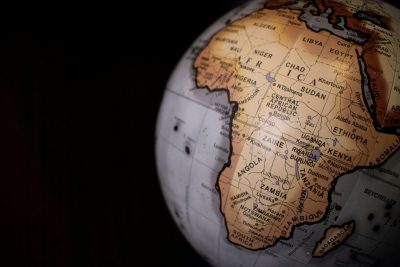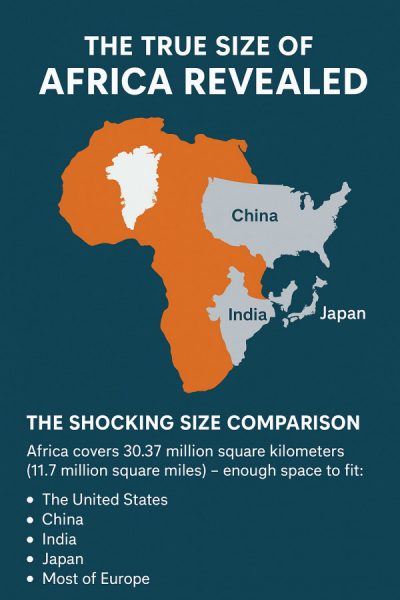Open Secret: The True Size of Africa Revealed
 —
—
The True Size of Africa Revealed
For centuries, the world has looked at Africa through distorted maps. The reality? Africa is far bigger than most people realize. Africa covers 30.37 million square kilometers (11.7 million square miles). That’s enough space to fit: The United States, China, India, Japan, Mexico, and most of Europe all within its borders.
On the popular Mercator map, Africa looks about the same size as Greenland. But here’s the truth: Africa is 14 times larger. While China and the U.S. each cover around 10 million km², Africa triples that size. This scale makes Africa the second-largest continent on Earth, holding 54 nations and more than 1.4 billion people.
How Did the Maps Get It Wrong?
The distortion to Africa’s true size comes from the Mercator projection, which was created in the 1500s to help sailors navigate oceans. It stretches landmasses farther from the equator, making them look bigger than they are. That’s why Greenland looks huge and Africa looks small. The closer a country is to the poles, the more inflated it appears. The closer it is to the equator, the more it gets squashed.
Using Mercator maps in classrooms for centuries gives students and global citizens a warped sense of scale. This warped sense of scale is arguably responsible for the distortion of the perception of Africa’s place and importance in the world. This is not just about geography, but about power and perception. Correct maps would show Africa’s real size, changing how people understand global importance.
The Call for Correction
Recently, campaigns have gained traction to replace Mercator with more accurate projections. The African Union supports these moves, noting that geographical representation directly influences how Africa is respected on the global stage. Decolonizing world history and education starts from presenting facts with accuracy. Realistic cartographical images are a vital part of the decolonization of global modern education. On it’s part, the African Union has emphasized that “a map is never just a map.” Maps shape how the world sees regions, their value, and their influence. Shrinking Africa has contributed to a narrative that minimizes its role in global affairs. Correcting maps is part of dismantling colonial legacies that still affect perceptions today.
Restoring Africa’s True Image
Showing Africa’s true size does more than fix a cartographic error. It restores the dignity of a continent too often underestimated. It reminds the world of Africa’s vast resources, rich civilizations, and critical role in the future of humanity. The maps on our walls, in our schools, and on our screens need to reflect this truth: Africa is massive, powerful, and central to humanity’s shared story.
The African Union recently formally endorsed the Correct the Map campaign, advocating for a transition away from the Mercator projection toward alternatives like the Equal Earth projection (developed in 2018). This movement highlights how cartography influences not just geography, but identity, education, and global power dynamics. Institutions are beginning to phase out Mercator, signaling tangible progress in public understanding and representation. Advocacy groups Africa No Filter and Speak Up Africa are driving this campaign, aiming to see the Equal Earth projection adopted in classrooms across Africa and by global institutions including the World Bank, the United Nations, and others.
Several institutions have already begun the shift. The World Bank uses Winkel-Tripel or Equal Earth in static maps and is phasing out the Mercator on web platforms. Google Maps has moved desktop users to a 3D globe view, though Mercator remains the default on mobile apps. Correcting the size of continents on the world map is more than a technical fix. It is a reclamation of dignity, which allows for an honest representation of Africa’s vast resources, rich civilizations, and growing role in the world. Using true-scale maps nurtures pride, reshapes narratives, and affirms the continent’s rightful place at the center of global discourse.
Key Updates from Recent News:
Recommended articles:

